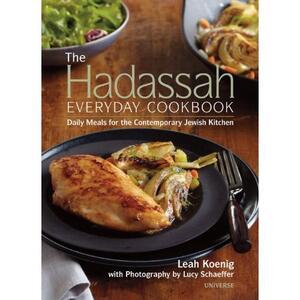The Hadassah Everyday Cookbook: A great addition to your cookbook collection
Due to the proliferation of food blogs and cooking websites with thousands of recipes at our fingertips, some folks question the need for cookbooks at all. I am not one of them. My own cookbook collection keeps growing (which shouldn’t come as a surprise to anyone) because even though finding recipes online is convenient, it will never replace using a well-written cookbook. When done right, a cookbook is carefully put together, the recipes are chosen and tested with care, and they are clear and easy to follow. All this works to create a volume that provides the cook with a useful tool in the kitchen and I think Leah Koenig (a food writer I greatly admire) did just that when she created The Hadassah Everyday Cookbook.
Unlike many Jewish cookbooks that focus on the holidays or are filled with complicated recipes that you would only be inclined to prepare on special occasions, this cookbook is filled with recipes for everyday meals: “This Jewish cookbook, then, takes a slightly different focus than most-tackling the everyday question, 'what’s to eat?'” It can sometimes be difficult to decide what to make for meals on a daily basis and this cookbook does a good job of offering up delicious and relatively easy recipes to fulfill this need.
The book is divided into eight sections, namely Breakfasts and Bread, Salads and Spreads, Sandwiches and Pizzas, Soups and Stews, Sides, Mains, Sweets, and Anytime Snacks. I think all of these sections are contain terrific recipes, but the section I appreciate the most is Breakfasts and Bread because more often than not this section is left out of cookbooks. Perhaps this is because breakfast is generally either something quick on a weekday morning or on the weekend, a more elaborate meal that is left to the professionals at a restaurant. Yet this section is filled with ideas for both of these times, and includes recipes such as Granola with Tahini or Cardamom-Scented Oatmeal for those mornings when things are more hectic or recipes such as Blueberry Cornmeal Pancakes or Smoked Salmon Scrambled Eggs when you’d like to create a breakfast to linger over.
This is a volume that can be used by beginners or those that are more comfortable and experienced in the kitchen. There are useful tips offered up throughout the cookbook, from those at the beginning of the book that suggesting how to get the most out of this cookbook and your time in the kitchen, to others interspersed among the recipes that are meant to help during the cooking process. These include how to make your own brown sugar, how to de-stem greens and how to successfully remove the seeds of a pomegranate without staining yourself and your kitchen.
The recipes in this cookbook are all kosher, with an indication as to whether a recipe is meat, dairy or pareve (neither meat nor dairy). However, regardless of whether you keep a kosher home or not, the recipes are so delicious that they will be appealing in either case. You have at your fingertips new recipes, such as Broccoli Black Bean Nachos or a Cauliflower and Caramelized Onion Quiche, as well as new takes on traditional recipes such as Orange Chocolate Macaroons, Grilled Tzimmes or an Apple Walnut Bread that I wrote about for Rosh Hashanah which takes the flavors of apple cake and transforms it into a delicious loaf. Menu ideas combining recipes from throughout the cookbook provide suggestions for various occasions ranging from a "Lazy Sunday Brunch" or "Kids’ School Lunch," to a "Simple but Elegant Dinner Party."
I highly recommend this cookbook. I know it’s one I will be referencing again and again, and I have no doubt that my own copy will soon bear the telltale food stains of a well-loved cookbook.








I wanted to apologize to readers for not having provided clarification as to what the term pareve meant in my post (there was initially some confusion about this). Working with these terms on a daily basis, I can sometimes become over familiar with them. However, I'll make sure to define such terms in the future.
What a lovely review - thank you so much! I'm so glad to hear that you're enjoying the recipes. :)
In reply to <p>What a lovely review - by Leah
Leah, I'm so glad you liked the review! I admire your work and I was glad I could write about this cookbook :)
I love this cookbook. Several of the dishes have become staples.
Also, pareve does not mean it's kosher for Passover. Pareve means it's neither meat nor dairy and can be used as an accompaniment to either but not both together.
In reply to <p>I love this cookbook. by Jane
Thanks for clarifying the meaning of "pareve." It's been corrected above!